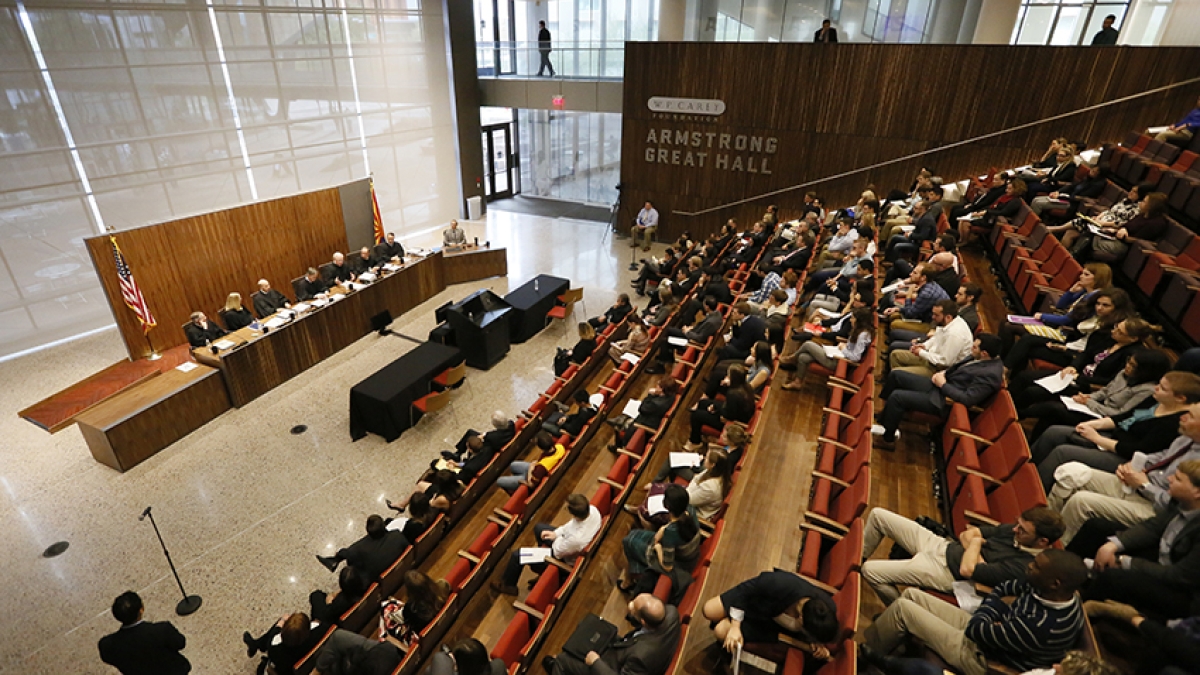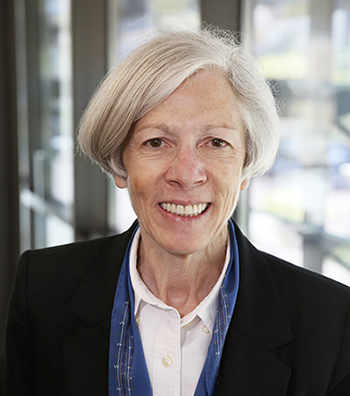All-star lineup of judicial adjuncts helps lift ASU Law to top 25 ranking

The Sandra Day O’Connor College of Law at Arizona State University has had a meteoric rise in its first half-century of existence, establishing itself as one of the top-ranked law schools in the United States. In that relatively short period of time, it has surpassed many of the nation’s most prestigious institutions to become a top 25 law school in the U.S. News & World Report rankings.
ASU Law has achieved its success by leveraging the unique assets of the Phoenix metropolitan area, including one particularly precious resource: some of the most brilliant minds in the judicial branch of government. From local and federal judges to Supreme Court justices, adjunct professors from the surrounding judicial community have been a driving force behind ASU Law’s ascension.
Adjuncts fill a critical role in the vast, ever-evolving world of legal education, allowing ASU Law’s esteemed full-time professors to focus on their particular areas of expertise.
“No law school can really hire a faculty that’s expert in everything the students will eventually be practicing, nor should they,” said longtime adjunct Judge Andrew Hurwitz, who serves on the U.S. Court of Appeals for the Ninth Circuit. “And particularly for the second- and third-year courses, where somebody decides they want to be a patent lawyer, having a patent practitioner may be the only way you can get an expert to teach a course.”

Andrew Hurwitz
The fifth-largest city in the United States, Phoenix is not only the seat of the Maricopa County government but also the nation’s most-populous state capital and home to the Sandra Day O’Connor U.S. Courthouse. So after moving from Tempe to the brand-new Beus Center for Law and Society in 2016, ASU Law now sits in the heart of downtown Phoenix, at the confluence of city, county, state, and federal government.
“Its access to adjunct professors is something that distinguishes it in a very positive way,” said Arizona Supreme Court Justice Clint Bolick, who will be making his adjunct debut this fall, teaching a class on constitutional law. “ASU Law takes advantage of its geographical location, especially with its new campus in Phoenix, to bring in judges and other experts on the law. And I think that enhances the learning experience for the students.”
The list of ASU Law adjuncts includes some of the biggest names in the legal community, including the school’s namesake, Sandra Day O’Connor, who co-taught a class with Arizona Supreme Court Justice Scott Bales shortly after her retirement from the U.S. Supreme Court.
“I think the students really appreciated the opportunity to be in a class with her,” Bales said.
Brian Richardson, a 2017 ASU Law graduate who took several classes taught by federal judges, is thankful for the close guidance and invaluable advice he received.
“Being a law student is a great time to take advantage of rare opportunities that won’t appear again for a long time,” Richardson said. “Getting to work with these judges in an academic setting is one of those opportunities. You get to know the judges and learn from them in an almost one-on-one atmosphere, since the class sizes are so small. Working on challenging issues together with them teaches you to think in a whole new way that brings what you are learning in the classroom into the context of the real world.”
Community partnership
ASU Law, which opened its doors in 1967, is the youngest law school on U.S. News & World Report’s top 25 list — by a considerable margin. Its rise to prominence has mirrored Phoenix’s decades-long growth spurt, and the important role played by adjuncts is just one example of the symbiotic relationship between the law school and the Valley of the Sun.
Judge Patricia Norris, who is retiring this summer after 14 years on the Arizona Court of Appeals, attended ASU Law during its first decade and says community leadership has always been part of the school’s core mission.
“I started law school in ’74 and graduated in ’77, and even then we had various groups on campus that encouraged the law students to be involved in the community,” Norris said, recalling a number of pro bono programs, including one to help low-income taxpayers. “None of us were tax experts, but we all spent several hours learning basic information about how to complete a tax form. During the spring, we would go down to various locations, mostly in south Phoenix or in Maryvale, and we would man the centers for three or four hours, a couple times a week, until April 15th, and help people who oftentimes just did not understand how they should complete a tax return.”
And just as she helped ASU Law give to the community as a student, Norris has also helped the community give back to ASU Law as an adjunct. After working in private practice at the Lewis and Roca firm for over two decades, she was appointed to the Arizona Appeals Court in 2003. And all the while, she has maintained a close relationship with the law school, serving as both a volunteer and an adjunct professor.
“There has been a real appreciation by the law school that it should have a presence in our community, and it shouldn’t be separate and isolated,” Norris said. “It’s a state law school, therefore the taxpayers are involved and invested in the institution, and this is an institution that really gives back to the community. And in my view, that has always been true.”

Scott Bales
Bales has been teaching as an adjunct at ASU Law for the better part of 30 years, and he says the school has fostered that collaborative relationship. “ASU Law historically has been very engaged in the community. And by that I mean the legal community but also the broader political and business community. And I think that’s something the school embraces and will continue to do.”
Those sentiments are echoed by Hurwitz, who began teaching as an adjunct at ASU Law in the 1970s: “I’m very fond of the law school. It is the only public law school – and for a long time it was the only law school – in the fifth-biggest city in the country. And therefore it’s played an outsized role in this legal community that I’ve been part of for over 40 years. The school, its resources, its professors, its clinics have played a very important role in Arizona, particularly in the Maricopa County area in terms of the development of the law and its enforcement.”
A higher calling
While balancing busy court dockets, enormous responsibilities and their personal lives, what compels some of the highest-ranking judges in the state to take on additional work as adjunct professors? It’s not for financial gain. In fact, Norris says Arizona law prohibits state judges from being paid by another state agency, meaning their adjunct work at ASU Law is truly pro bono.
Instead, they are motivated by their respect for the legal profession, a pay-it-forward sense of duty, a genuine fondness for teaching, and, in some cases, each other.
“Chief Justice Bales’ work in the classroom has certainly inspired me,” said Bolick, who originally went to college to become a teacher before concluding, after a student-teaching stint, that he could do more for education in the courtroom than in the classroom. “When Governor Ducey appointed me, he had one request, and that is that I continue speaking and writing as much as I possibly can. And I plan to honor that commitment, and this is a great way to do it.”
Norris, like Bolick, once considered a teaching career, minoring in secondary education. “I always enjoyed working with young lawyers, and it just seemed like a natural fit after I started to learn my craft as a lawyer to help others learn their craft.”
And teaching at ASU Law also provides a professional benefit.
“When you teach, you have to stay on top of your game,” Norris said. “You have to make sure that you’re not just dusting off old notes, that you are aware of changes and different approaches. So by teaching, you get a benefit out of it, because you’re going to stay on top of the subject matter.”
Hurwitz agrees, explaining that the judges’ own exacting standards as instructors force them to stay sharp, which benefits them in their other jobs: “Every year, I sit down once again and go through the syllabus and see what the current cases are and try to rethink them. And when I taught civil procedure, I did the same thing. It’s a very current field, and so it required me every year to make sure I knew what had happened in the last year. It’s educating yourself to teach the courses, and it’s very helpful in what we do.”
And no matter how busy their court schedules get, the adjunct professors are fully committed to their teaching responsibilities.
“I think that some people think, ‘Well, if you’re an adjunct, you’re not going to be as engaged, because after all, you have a day job,’” Norris said. “I can tell you from my personal experience, and also talking with other judges who have been adjuncts, and also other lawyers who have served as adjuncts, that it is not teacher-lite. And not only do the adjuncts take it very seriously, but they spend an enormous amount of time.”
Tyler Carlton, a current ASU Law student, can attest to that. He has taken two classes taught by judicial adjuncts — Hurwitz and retired Maricopa County Superior Court Judge Colin Campbell — and said the level of engagement, and quality of instruction, was second-to-none.
“I loved having Judge Hurwitz, because he was a wealth of knowledge, and he really took the time to go beyond the material and really help us grow as lawyers,” Carlton said. “It was the same thing with Judge Campbell. It was extremely beneficial to have someone who was on the other side of the bench telling us practical advice about how to get your client the remedy they are seeking. I think having a judge as a professor is great, because they are just people who have clearly succeeded immensely as lawyers – so who best to go to for experience but the experts?”
Downtown Advantage
Teaching a class is indeed a significant time commitment. But with ASU Law’s move to downtown Phoenix, where so many judges and lawyers are based, the commute time for most adjuncts has been reduced considerably.
“It’s so much more convenient,” Hurwitz said. “I can be there in five minutes from my office. I used to spend an hour and a half on the roads with the course I taught, because by the time I got to Tempe and parked and got inside, it was 45 minutes.”
Bolick says it would be much more challenging to teach if the law school were not downtown. “With our court calendar, it’s tough to get away very often. But the fact that the law school is literally five minutes away, with a parking garage, makes it extremely easy to do this.”

Patricia Norris
And Norris thinks the move downtown should make it easier to recruit even more adjuncts: “Phoenix is the seat of government, so we have Maricopa County Superior Court two or three blocks away. We have the federal court two or three blocks away. We have a number of firms that are based in downtown Phoenix or maybe slightly uptown where they can take the light rail. And then of course you have our state appellate courts a few blocks away, and our seat of government. And so we have a lot of people who I think are going to want to be active in the law school because it will be so easy to do that.”
And the location isn’t just ideal for adjunct professors. It’s a benefit to the students, as well.
“The school has tremendous opportunities for internships and externships,” said Bales, who will be co-teaching a class this fall with Judge Murray Snow of the U.S. District Court of Arizona. “So while a student is studying, he or she will have the chance to be working in a judge’s chambers, or working for a prosecutor’s office, or working for a public defender.”
Carlton said he chose ASU Law because of its lofty national ranking and the reputation of its professors. Although the school’s proximity to so many courts and law firms did not factor into his decision, he said it’s something he now appreciates.
Bales said internships and externships, more so than when he was a student, are an important facet of a modern-day legal education. And ASU Law opens a lot of doors for such opportunities with its downtown location, sterling reputation, and tireless efforts to help its students. “So if I were a student, one thing I’d want to think about in choosing schools is, which schools have either the kind of expert extern and internships that I might be interested in, or have the range that I would like to sample.”
Added Norris: “For the law school’s students who want to have externs or internships, it’s easy for them to then join us here, and they don’t have to worry about an hour-long commute, and then I’ve got to find a parking spot, and then I need to figure out where I’m going to be. They can just take light rail or the DASH or even hoof it if it’s close enough, and they’re here. And I think it’s a great advantage.”
Rewarding experience
ASU Law has a lengthy list of accomplished graduates, including business leaders, local politicians, and members of Congress. And there’s a tremendous sense of gratification when adjuncts see their former students reach such heights.
“I’ve had former students that have served in the Legislature, the chief deputy of the Attorney General’s Office, Mike Bailey, was a student of mine years ago. And another former student of mine is a candidate for the Arizona Court of Appeals,” Bales said. “You see that and it’s pretty gratifying.”
And the business relationships and lifelong friendships that are forged are one of the fringe benefits that keep the adjuncts coming back.
“I’ve always been grateful to the law school for letting me teach,” Hurwitz said. “I’m sure I’ve gotten more out of it than I’ve given. I enjoy it every time I do it. I end up making lifelong friends with students, some of whom are my clerks, some of whom were associates and partners in my law firm. I end up making lifelong friends with faculty members. And so it’s just been a wonderful opportunity for me.”
Richardson has taken classes taught by Hurwitz and U.S. District Judge Douglas Rayes, as well as a neuroscience research seminar taught by U.S. District Judge Roslyn Silver. He said the judges bring a wealth of experience into the classroom, which is not only educational but also entertaining.
“Judges always have the best stories,” he said. “That was always one of my favorite parts of these courses. Of course, there’s nothing like having a judge go through your writing, and seeing how much better you can be as a result of working with them.”
As for Bolick, ASU Law’s newest adjunct, he is thrilled to be returning to the classroom years after that initial student-teaching experience. And the Supreme Court justice hopes to live up to the school’s lofty adjunct standards.
“I am really looking forward to it, very, very excited,” he said. “And I will certainly be far more nervous than the students.”
More Law, journalism and politics

ASU launches nonpartisan Institute of Politics to inspire future public service leaders
Former Republican presidential nominee and Arizona native Barry Goldwater once wrote, "We have forgotten that a society…

Annual John P. Frank Memorial Lecture enters its 26th year
Dahlia Lithwick, an MSNBC analyst and senior legal correspondent at Slate, is the featured speaker at the School of…

The politics behind picking a romantic partner
A new study reveals the role that politics play when picking out a romantic partner — particularly for older adults.“Findings…